-

人教版新目标初中英语八年级下册Have you ever been to an amusement park教案
(1)Have you ever been to …? Yes, I have. / Yes, I have ever been to …No, I haven’t. / No, I have never been to …(2)When did you go there? I went there last year. (3)I have never been to a water park. Neither have I. I have ever been to an amusement park. So have I. (4)How long have you been studying English? I’ve been studying English since nine o’clock. I’ve been studying English since I came back home. I’ve been studying English for five hours. (5)What’s that? It’s an amusement park in Japan. I’ve never been to an amusement park like it before. It’s fun to learn another language. Let’s go tonight. Isn’t this great?space museum, amusement park, water park, South America, Peru, Holland, European culture, tour guide, flight attendant, musical instrument, more than, be from, get to, take lessons, neither, discover, graduate, change

人教版新目标初中英语八年级下册Why don’t you get her a scarf教案
教师带领学生复习有关描述宠物的词汇,采用教师提问学生回答的方进行。如:T:What animals do you think would be good pets?What animals do you think would be bad pets?What do you think are good animals for a six-year-old child?然后学生进行 pairwork 练习。Task two: 师生互动,学习探究 1、播放3a部分的录音,引导学生一边听录音,一边跟读。2、通过听录音学生回答以下问题:Why do you think pot-bellied pigs are popular?What are the advantages and disadvantages of keeping such a pet?教师对学生的回答进行及时点评。3.学习范文,学习重点短语,为下步的模仿写作提供语言素材。T :1. )Have you ever kept a pig as a pet?Do you like pigs? St.:No.…Why don’t you like to keep a pig? St: No.They’re too dirty and lazy(Do you know in some foreign countries like Hollyland, Australia,pigs are the most popular pet.there’s a kind of pig.(图)it has an interesting name? it ‘s called a pot-bellied pig.) Now,let’s learn an article about this kind of interesting pet.2.)play the tapeSt.:Listen and repeat3.)show some Qs on computer(本子St.: read silently,then answerthe Qs(本子)4.)Ask ss. Close book and retell this passage.(what is a pot-bellied pig? Is it a good or bad pet? ) St.: retell it to each other“A pot –bellied pig is a popular pet now…”5.read the article together.St.:.practice reading

人教版新目标初中英语九年级下册By the time I got outside, the bus had already left教案
Ⅰ. Teaching Aims and Demands1. Knowledge Objects(1) Key Vocabularyoversleep(2) Target LanguageWhat happened?I overslept. And by the time I got up, my brother had already gotten in the shower.2. Ability Objects(1) Teach the students to use the new words.(2) Train the students to narrate past events with the Past Perfect Tense.(3) Train the students' listening and speaking skills with the target language.3. Moral ObjectIt’s a good habit to go to bed early in the evening and get up early in the morning. So you’ll never be in a hurry in the morning.Ⅱ. Teaching Key Points1. Key Vocabularyoversleep2. Target LanguageNarrate past events with the Past Perfect TenseⅢ. Teaching Difficult Points1. Train the students to narrate past events with the Past Perfect Tense.2. Train the students to understand the target language in spoken conversation.Ⅳ. Teaching Methods1. Thinking of examples from the students' real lives.2. Making sentences by looking at the pictures.Ⅴ. Teaching AidA tape recorderⅥ. Teaching ProceduresStep I Revision1. Revise the language points in Unit 8.Ask some questions like this: What volunteer work would you like to do?Help the students to answer, I’d like to…/I love to…/I hope to2. Practice the dialogue in Activity 3c on page 62 again. Get students to role play the similar dialogues with the following.

人教版新目标初中英语九年级上册It must belong to Carla教案
一、Section A该部分有4个模块。第一模块围绕Whose volleyball is this? 这一话题展开思维( 1a)、听力(1b)、口语( 1c)训练;第二模块围绕上一模块中的话题进行听力( 2a-2b)、口语训练( 2c);第三模块继续围绕前两个模块中的“making inferences”展开训练。训练形式为阅读排序( 3a)和两人问答(3b);第四模块仍就上一话题展开讨论。二、Section B该部分有4个模块。第一模块要求根据图画和所提供的单词写出合理的句子;第二模块在听力( 2a-2b)和分角色口语训练( 2c)的基础上,继续进行“推测”训练; 第三模块围绕“Strange events in Bell Tower neighborhood”这一话题展开阅读( 3a)和写作(3b -3c)训练;第四模块以dream为话题展开小组活动。三、Self Check该部分有3个模块。第一模块以填空形式对所学词汇进行训练;第二模块就8个谚语展开阅读和讨论。

人教版新目标初中英语九年级下册Could you please tell me where the restrooms are教案
Step Ⅰ RevisionCheck homework. Ask a few students to read the article in 3a.Then ask a few students to read their guides.Step Ⅱ Part 1Look at the words in the box. Ask a student to read them. Make sure the students understand the meaning of the words. You are to fill in the blanks with the words. In some cases, students may need to use another form of the word, for example adjusting for tense or subject/ verb agreement.Ask students to fill in the blanks on their own.Check the answers. Step ⅢPart 2Go through the instructions with the class.Look at the example with the students.Ask students what the answer would be.Ask a student to read the question and answer it.Excuse me, could you tell me where the bank is, please?The bank is across the street from the shopping malt.Get students to complete the work in pairs.Check the answers. Ask a few students to read their questions.Step Ⅳ Just for Fun!Ask all the students to read the conversation. Ask: What is funny about this cartoon? Help students to explain. A Martian is a person from the planet Mars.There is no such thing as Martian food on Earth, and the clerk looks silly because he is trying to think of where there is a Martian restaurant.Invite some pairs of students to present this conversation to the rest of the class.Step Ⅴ Summary and HomeworkIn this class, we’ve done much writing practice using the key vocabulary words and the target language presented in this unit. After class, please finish the questions in 2 in your exercise books. Then finish the exercises on pages 47~48 of the workbook as well.The Seventh Period Ⅰ Teaching Aims and Demands1. Knowledge Objects(1) Key Vocabularyimage, adventure, jealousy, hero, crime, journey, brave, no longer, show interest in, take it easy, become interested in, plain looks(2)Text:Grown-ups like cartoons, too.2. Ability Objects(1) Fast-reading to get a general idea of the text.(2) Careful-reading to get the detailed information in the text.

人教版新目标初中英语七年级上册Do you have a soccer ball教案
在这一单元中,学生要学会就有关人与物之间所属关系进行问答的句子。本单元大量引入有关运动的名词,要求学生彼此询问有无此类物品,并做出相应的回答。 同时学习表示建议的句型Let’s运动的形容词。 本单元所选用的话题来自学生所喜欢的生活片段,在教学中生生交流、师生交流会更融洽,会促进师生彼此间的了解,成功的教学还会让部分学生养成良好的运动习惯和收藏习惯。 教学目标 1) 语言知识:A.在询问对方是否有某物的对话中学会使用do和does引导的一般疑问句; B. 学会使用描述性的形容词来评价事物; C. 学会在对话中使用名词复数; D. 学会用祈使句来向对方提出建议. 2) 语言技能:A. 学会用祈使句询问某人是否有某物; B. 学会向他人提出建议的句子. 3) 学习策略:A.通过与同学讨论,做出猜测;

人教版新目标初中英语七年级上册What’s this in English教案
一、知识和能力目标本单元的核心教学内容是“认物”。用英语确认周围的常见事物比较符合英语初学者的实际情况。通过本单元教学,使学生运用所学句型,去熟悉周围事物的名称;教学生学会在实际生活中如何确认事物。通过辨认物体,学生学到一些生词,并巩固所学句型。二、过程和方法目标教师要尽量使学生对课文中出现的句型能够熟练上口,这样,学生才能顺利开展比较灵活的对话。教师可以用手势,表情,动作等示意,帮助学生听懂课堂教学内容,但在实际操作中应尽量避免“明知故问”的倾向,应该采用应用性原则;如:遮盖物品、显露局部、辨认物体、完形识别、图形辨认等方法。三、情感态度和价值观目标目标在学生学习过程中的作用至关重要,教师要帮助他们建立起一个切合自己实际的目标,通过渐进的学习以及一点一滴的进步,使他们逐步建立起成功感。成功越多,自信心就越强。

人教版新目标初中英语七年级下册Where is your pen pal from教案
2.1Match the country with the language.Step II Reading3a? let the students read the letter fast and answer the questions.? Let the students ask more questions about the letter as possible as the can.Step III Writing3b.Step IV. Pairwork2cStep V Listening2a, 2bStep V. HomeworkExercises book(1) P3Exercises book (2) P3Period FourStep I . Dictate the words and sentences in Unit1.Step II. Self-checkStep III. Check the answers for Exercises book in the unit.Step IV. Home workRevise and preparation for unit 2.教学反思:通过本单元的学习,学生基本可以谈论人们的国籍,居住城市及其所说的语言,通过书信方式去介绍自己并寻找笔友。但在涉及到国外的一些城市时,学生对这方面的知识相对欠缺,能介绍的城市并不多,也反应出学生课前预习不充分,这跟学生学习条件也有关,大多数学生无法通过网络获取所需信息。因此,在以后的教学中要多指导学生通过计算机网络获取信息,拓宽知识面。

人教版新目标初中英语七年级下册What do you think of game shows教案
五、教学Section B-2c1. Pair work: What do you think of the belt/sunglasses/…? What does your father/mother/… think of your scarf/belt…?2. Group work(1). Teacher shows some different kinds of school uniforms (制服)and asks : “ What do you think of your school uniforms? If you have a chance to choose your school uniforms, what kind would you like to choose?”(2). Discuss in groups.(3).Get some Ss to report in class.说明:这一步旨在让学生运用已有的语言知识谈论对事物的看法和意见,并简单阐明理由,培养学生的主动思维能力和运用英语的能力。六、教学拓展调查电视节目的收视率任务:调查你周围的人对现在各种电视节目的反响。活动过程:1.教师布置任务,让学生调查周围的人(包括他的亲戚朋友和邻居)喜欢收看哪方面的电视节目。2.学生进行调查活动,运用本单元所学的句型What do you think of….? (Why?)What's your favorite game shows?What do you think of talk show?I doesn’t mind it.I like it.I love it.I can’t stand it.3.记录下排在前10位的TV Program,填写调查表,比较其收视率。

人教版新目标初中英语八年级上册Could you please clean your room教案3篇
一、 教学内容Section A 1a----1c二、 教学目标1.学习词汇do the dishes, make the bed, take out the trash, fold the clothes, do the laundry, sweep the floor, clean the living room.2.句型 Could you please clean your room? Yes, sure.三、 教学准备 学生预习本单元所有的词汇多媒体课件 活动表 奖品四、 教学过程Pre-task1. Warming upEnjoy ourselves. Watch cartoon Cinderella. 看动画片段《灰姑娘》导如入本课话题和新词汇“chores”美丽善良的鬼姑娘因继母的嫉妒,每天得做所有的家务。片段的主题使学生联想到本课的话题。2. learn new words and phrasesLook! What is she / he dong? 看图学习动词词组do chores, do the dishes, make the bed, take out the trash, fold the clothes, do the laundry, clean the living room.3. Guessing game.What is she doing ? 4. Pair work. 1a, Do you do these things at home? Write “Y” for “yes” and “N” for “no”.5. Listening . 1b , Peter’s chores or Mom’s chores?理解目标语Could you please clean your room? Yes, sure.Write “M” for Mom’s chores, “P” for Peter’s chores in the chart.6. PairworkLook at the picture,Ask your partner to do the chores that you see. 7. Interview Who is the most able at home? 1) What chores do you do at home? How often do you do the chores? Work in four, interview each of the students in the group, fill in the chart.

人教版新目标初中英语八年级上册I’m going to be a basketball player教案3篇
教学目标1.知识目标:(1)学习What are you going to be when you grow up?/How are you going to do that?句式。(2)学会用英语描述有关职业的表达法。2.能力目标:(1)能够谈论为实现理想所做出的打算和安排。(2)能够谈论未来自己与他人理想的职业及原因。(3)能用英语描述课余时间的活动安排,最终具备表达综合信息的能力。3.情感目标:新学期到来之际,让他们在学习、体育、饮食、特长、读书等方面制定计划,教育学生合理安排自己的课外生活,思考自己的理想职业及适合自己的职业。教学重点、难点本单元的重点为“be going to”表将来,want to be, what,where, when,how引导的特殊疑问句。难点是语言目标的实现。教材分析本单元以I am going to be a basketball player为话题,共设计了三部分的内容:一、Section A该部分有4个模块。第一模块围绕Do you think these jobs are interesting?这一话题展开思维(1a)、听力(1b)、口语(1c)训练;

人教版新目标初中英语八年级下册Would you mind turning down the music教案
Step 4. Group work (4)1. Ask a pair of students to read the dialogue. Say, This activity provides speaking, listening and writing practice using the target language.2. Ask students to complete the work in groups.3. Check the answers with the whole class. 4. Explain some of the language points. Step 5. Word review (Self check 1)1. Ask students to read the words and the phrases given. 2. Fill in the blanks with proper forms of these words to complete the sentences. 3. Check the answers with the whole class. Homework:Do activity 2 on page 57 after class. Period 6Teaching aims: 1. Teach vocabulary words and the useful expressions. 2. Enable the students to learn etiquette in different culture. 3. Help the students learn how to behave politely in public places and in daily life. Teaching procedures:Step 1. RevisionHelp students to review the function of making requests through a free talk. Then lead them to the topic of etiquette. Explain the meaning of etiquette. Or, ask students to look it up in the dictionary. Step 2. Pre-reading (Section 1)1. Ask students to read the picture and make a list with their partner about how many rules of etiquette can be seen being broken.
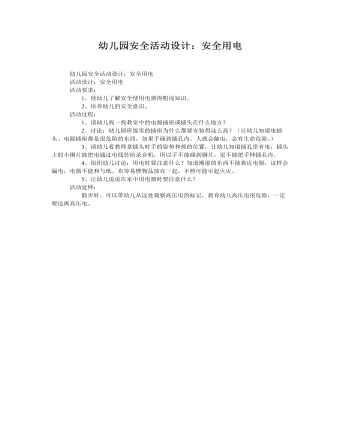
大班安全教案:安全用电
活动要求: 1、使幼儿了解安全使用电器得粗浅知识。 2、培养幼儿的安全意识。 活动过程: 1、请幼儿找一找教室中的电源插座或插头在什么地方? 2、讨论:幼儿园班级里的插座为什么都要安装得这么高?(让幼儿知道电插头、电源插座都是很危险的东西,如果手碰到插孔内,人就会触电,会有生命危险。) 3、请幼儿看教师拿插头时手的姿势和抓的位置,让幼儿知道插孔里有电,插头上的小铜片能把电通过电线传给录音机,所以手不能碰到铜片,更不能把手伸插孔内。
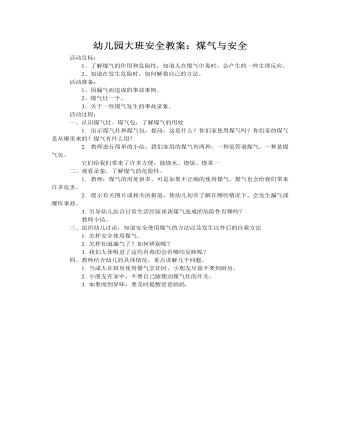
大班安全教案:煤气与安全
2、知道在发生危险时,如何解救自己的方法。 活动准备: 1、因漏气而造成的事故事例。 2、煤气灶一个。 3、关于一些煤气发生的事故录象。 活动过程: 一、认识煤气灶、煤气包,了解煤气的用处 1. 出示煤气灶和煤气包,提问:这是什么?你们家使用煤气吗?你们家的煤气是从哪里来的?煤气有什么用? 2. 教师进行简单的小结:我们家用的煤气有两种,一种是管道煤气,一种是煤气包。 它们给我们带来了许多方便,能烧水、烧饭、烧菜┄┄
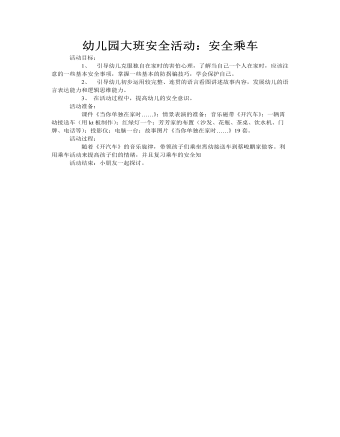
大班安全教案:安全乘车
2、引导幼儿初步运用较完整、连贯的语言看图讲述故事内容,发展幼儿的语言表达能力和逻辑思维能力。 3、 在活动过程中,提高幼儿的安全意识。 活动准备: 课件《当你单独在家时……》;情景表演的准备;音乐磁带《开汽车》;一辆霄幼接送车(用kt板制作);红绿灯一个;芳芳家的布置(沙发、花瓶、茶桌、饮水机、门牌、电话等);投影仪;电脑一台;故事图片《当你单独在家时……》19套。
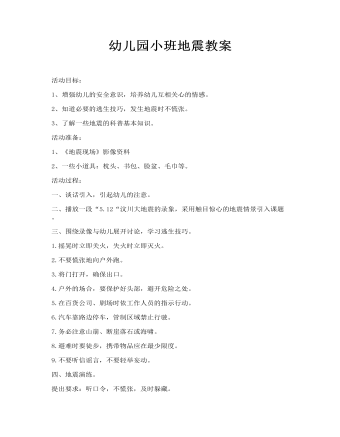
幼儿园小班地震教案
二、播放一段“5.12“汶川大地震的录象,采用触目惊心的地震情景引入课题。三、围绕录像与幼儿展开讨论,学习逃生技巧。1.摇晃时立即关火,失火时立即灭火。2.不要慌张地向户外跑。3.将门打开,确保出口。4.户外的场合,要保护好头部,避开危险之处。5.在百货公司、剧场时依工作人员的指示行动。6.汽车靠路边停车,管制区域禁止行驶。
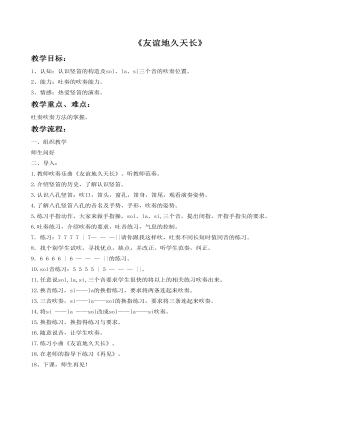
《友谊地久天长》教案
教学流程: 一、组织教学师生问好二、导入:1.教师吹奏乐曲《友谊地久天长》。听教师范奏。2.介绍竖笛的历史,了解认识竖笛。3.认识八孔竖笛:吹口,笛头,窗孔,笛身,笛尾,观看演奏姿势。4.了解八孔竖笛八孔的音名及手势,手形,吹奏的姿势。5.练习手指动作,大家来做手指操,sol、la、si,三个音,提出闭指,开指手指尖的要求。6.吐奏练习,介绍吹奏的要求,吐音练习,气息的控制。7.练习:7 7 7 7 | 7———||请你跟我这样吹,吐奏不同长短时值同音的练习。8.找个别学生试吹,寻找优点,缺点,并改正。听学生范奏,纠正。9.6 6 6 6 | 6 ——— ||的练习。10.sol音练习:5 5 5 5 | 5 ——— ||。11.任意说sol,la,si,三个音要求学生很快的将以上的相关练习吹奏出来。12.换音练习,si——la的换指练习,要求将两条连起来吹奏。13.三音吹奏,si——la——sol的换指练习,要求将三条连起来吹奏。14.将si ——la ——sol改成sol——la——si吹奏。15.换指练习,换指得练习与要求。16.随意说音,让学生吹奏。17.练习小曲《友谊地久天长》。18.在老师的指导下练习《再见》。18、下课,师生再见!
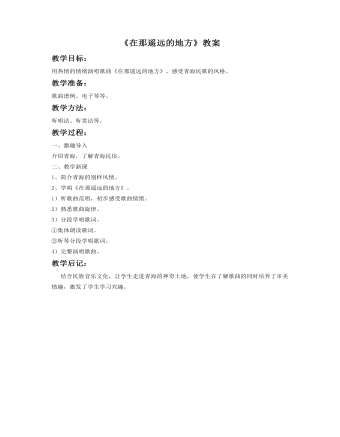
《在那遥远的地方》教案
教学目标:用热情的情绪演唱歌曲《在那遥远的地方》,感受青海民歌的风格。教学准备:歌曲谱例、电子琴等。教学方法:听唱法、听赏法等。教学过程:一、激趣导入介绍青海,了解青海民俗。二、教学新课1、简介青海的别样风情。2、学唱《在那遥远的地方》。 1)听歌曲范唱,初步感受歌曲情绪。2)熟悉歌曲旋律。3)分段学唱歌词。①集体朗读歌词。②听琴分段学唱歌词。4)完整演唱歌曲。教学后记:结合民族音乐文化,让学生走进青海的神奇土地,使学生在了解歌曲的同时培养了审美情趣,激发了学生学习兴趣。
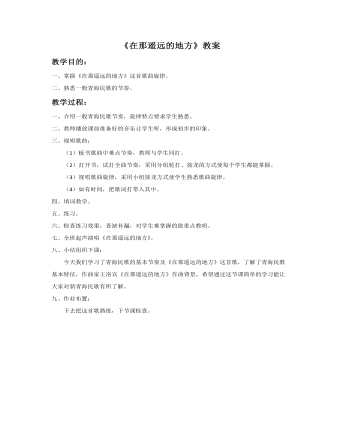
《在那遥远的地方》教案
教学过程:一、介绍一般青海民歌节奏,旋律特点要求学生熟悉。二、教师播放课前准备好的音乐让学生听,形成初步的印象。三、视唱歌曲: (1)板书歌曲中难点节奏,教师与学生同打。 (2)打开书,试打全曲节奏,采用分组轮打、接龙的方式使每个学生都能掌握。 (3)视唱歌曲旋律,采用小组接龙方式使学生熟悉歌曲旋律。 (4)如有时间,把歌词打带入其中。四、填词教学。五、练习。六、检查练习效果,查缺补漏,对学生难掌握的做重点教唱。七、全班起声演唱《在那遥远的地方》。八、小结组织下课: 今天我们学习了青海民歌的基本节奏及《在那遥远的地方》这首歌,了解了青海民歌基本特征,作曲家王洛宾《在那遥远的地方》作曲背景,希望通过这节课简单的学习能让大家对新青海民歌有所了解。九、作业布置: 下去把这首歌熟练,下节课检查。
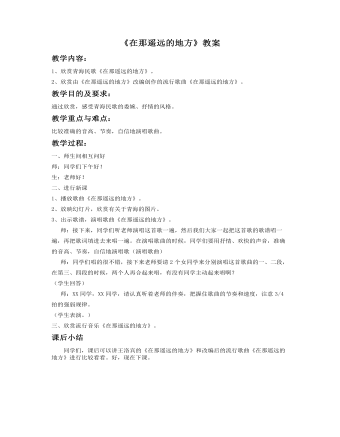
《在那遥远的地方》教案
教学过程:一、师生间相互问好师:同学们下午好!生:老师好!二、进行新课 1、播放歌曲《在那遥远的地方》。2、放映幻灯片,欣赏有关于青海的图片。3、出示歌谱,演唱歌曲《在那遥远的地方》。 师:接下来,同学们听老师演唱这首歌一遍,然后我们大家一起把这首歌的歌谱唱一遍,再把歌词填进去来唱一遍。在演唱歌曲的时候,同学们要用抒情、欢快的声音,准确的音高、节奏,自信地演唱歌(演唱歌曲) 师:同学们唱的很不错,接下来老师要请2个女同学来分别演唱这首歌曲的一、二段,在第三、四段的时候,两个人再合起来唱,有没有同学主动起来唱啊?(学生回答) 师:XX同学,XX同学,请认真听着老师的伴奏,把握住歌曲的节奏和速度,注意3/4拍的强弱规律。(学生表演。)三、欣赏流行音乐《在那遥远的地方》。